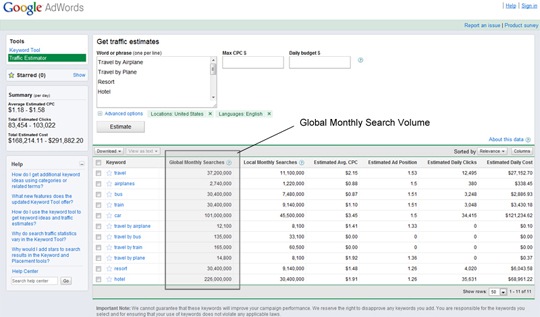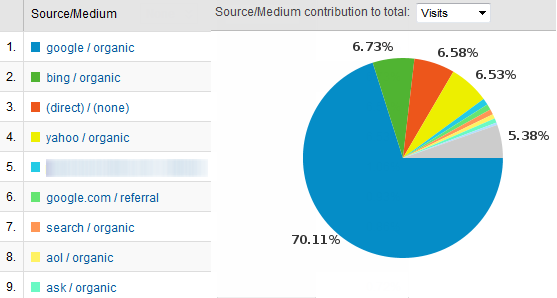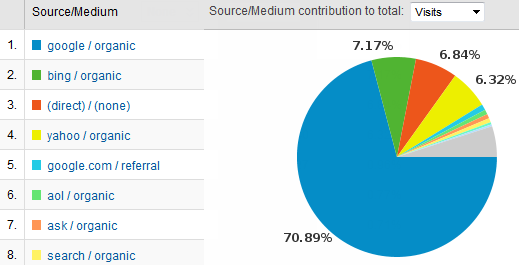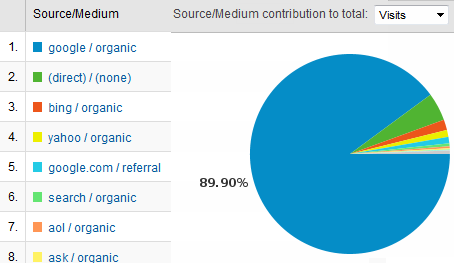Posted by randfish
One of the people I admire and respect most in the technology, startup world is Union Square Ventures' Fred Wilson. A little more than a year ago, I had the opportunity to sit down and chat with Fred in his New York offices, just as SEOmoz was ending a failed fund raising attempt. The writer I'd come to know and love through his blog and tweets shone through - he's affable, humble, smart and considerate. And his firm employed (at that time anyway) an analyst with professional SEO experience, who also sat in on the meeting.
Today, Fred wrote a post on his blog titled "Marketing."

I strongly disagree with the statement "marketing is what you do when your product or service sucks," and I mostly disagree that it only pays to use marketing when profit margins are insanely high. As I read it, part of me wondered , "Isn't the goal of venture capital to help a company scale faster than it could without funding?"
To be fair to Fred, what he calls "marketing" is what I believe many of us in the startup/tech space would call "advertising" or "paid customer acquisition channels." Later in the post, he says:

I disagree less with this point. For some startups, "free" customer acquisition in early stages certainly makes sense as the primary channel, though I'd question whether the right amount to spend is always $0.00. That strikes me as both extreme and rarely correct. At the very least, startups should be experimenting with paid acquisition channels that look compelling - ignoring them simply because they aren't free could really hurt your growth potential.
My Perspective on Startup Marketing
I've helped a lot of startups in various stages with marketing - through SEOmoz's old consulting business, through lots of personal relationships, through our Q+A and through events and conferences. Last year, YCombinator's Paul Graham invited me down to their Silion Valley offices for a pizza party where I talked about SEO for startups. I gave a similar talk at Seattle's Techstars a few months ago and a brand new one that I presented at Twiistup in Los Angeles just a couple weeks ago. I've embedded that presentation below:
I'm a huge believer in inbound marketing, which includes social media, content marketing (blogging, whitepapers, research, infographics, etc.), SEO, video, Q+A and comment marketing and loads of other free (or mostly free) channels. Inbound marketing is a powerful way to make consumers aware of your business and your products, and in my opinion, it's one in which people don't invest nearly enough. I'm worried that Fred's post will re-inforce a harmful stereotype that I see a lot in the tech startup world.
Product is All That Matters?
For the first few years that I was in the "web world," 1997-2001, there was a dangerous and obvious bias in startups toward sales and marketing - and branding in particular. But, in the past few years, that pendulum has swung to the equally dangerous paradigm that product is everything.

Don't get me wrong - I think a product-bias in a startup is an extremely healthy thing to have. SEOmoz's focus is ~65% product, 35% everything else, and that ratio is likely to be more product-biased in the future. But I see so many great startups who need, more than anything, to GET THE WORD OUT.
Let's look in Union Square's Ventures portfolio:
- Zemanta - one of USV's companies that everyone who reads this blog should probably know about, yet I'd guess that <10% do. Certainly, Zemanta has cool product opportunities that it can and should execute, but they also seriously need to better reach the search marketing community. I've seen them doing so somewhat actively - sponsoring and speaking at events, some content marketing and outreach, case studies and networking (and that's just what I've personally observed).
- Clickable - another USV-backed venture that's in the marketing space; Clickable helps advertisers manage all their account on Google, Bing, Facebook and more in one place (which is awesome). Again, I think a 70/30 product/marketing balance makes sense, but there's no way they shouldn't be using the power of inbound marketing to build awareness and bring their market to their site. No offense intended, but the Clickable blog, with its anonymous icons and erroneous Facebook integration (note that the same number of people "like" every post) could use some marketing TLC.
- Etsy - back in 2009, when SEOmoz had a small consulting arm, we helped Etsy on some SEO and community outreach features. From what I've heard and seen, that effort paid off. Here's some Google Trends data (which, granted, is far from perfect):

Some of USV's companies - Twitter, Foursquare, Meetup and, to a slightly lesser extent, Stackoverflow - may indeed have product built around natural marketing. The very act of using the services creates an incentive to share, to participate and to discover. But, quite honestly, this is not the reality for most startups, especially those who are B2B focused.
In fact, there are a ton of great startups that need at least as much marketing as they do product growth. For example:
- Trunk.ly - already a phenomenally useful and addictive product. My understanding is they're seeking investment to help grow/scale and, more than anything, they need a few dozen to hundred more evangelists and articles extolling their virtues. I think even Fred would agree that marketing is a "must."
- Namesake - a very cool conversation and opportunity platform, Namesake is another example of a startup that could benefit from significantly more brand-awareness and participation. Whatever dirt Quora has on TechCrunch's editors - yeah, they should get some of that.
- The Resumator - following several years of successful operation and growth, Resumator has a lot of customer feedback and a fairly mature product that's truly useful and powerful. Awareness among HR professionals and SMBs who struggle with the inefficiencies of hiring, however, is low. It's possible some unique product features would skyrocket Resumator to the moon, but I'd guess that marketing (both inbound and through paid channels) is one of the best investments they can make.
- Markup.io - this seriously slick and useful app could certainly benefit from additional features and product maturity, but it's already solving a big pain for web workers of all stripes. More people who have this pain need to know about Markup - marketing is the answer (at least, to that problem).
I'm not a believer that a market will simply flock to a great product. Many great products have died due to obscurity; only a few great products have succeeded in spite of rejecting marketing. Fred uses the examples of Twitter and FourSquare; Google could be another reasonable example. Those are outliers, and while they might be the types of companies Fred is seeking to invest in, they're the exception, not the rule, and thus I worry that the advice and perspective will have the wrong impact.
An Update from Fred
As I was writing this post, Fred published an update he called "The Bug Report." Unfortunately, in my opinion, there's still a lot of bad advice.

Ack! Fred is, whether intentionally or not, one of the startup world's most influential marketers and that carries over to the companies he invests in as well. When Zemanta's team reached out to talk to me, they had only to mention Fred's backing to get my attention. When Fred first started writing about Disqus, using their plug-in on his site and evangelizing their value, he became one of their biggest marketing channels.
Fred Wilson is, undeniably, a powerhouse of an inbound marketer. When I saw that he was writing about marketing, I hoped to hear his perspective on the incredible channels he's built through content and social media. I wanted to know how he helped to bring legitimacy and media attention to New York as an emerging startup epicenter. I was curious about how he built a following on his blog, how he picked topics to write about, how he coached his companies to build their own inbound marketing. I was hoping for the same transparency on his clearly strategic and well-planned marketing campaigns (e.g. the startup visa) that he offers with his MBA Monday series.
And reading his posts, I felt let down. Perhaps I've just been so impressed with the rest of his written work that my standards are too high.
The final point of contention between us is Fred's view on marketing professionals:

Being not only a marketing professional, but someone who's done work to help Fred's portfolio companies with marketing, it's hard not to take personal offense. I don't know if he'd loop in the consulting efforts we provided to Etsy or the small amounts of pro bono assistance I've given to Zemanta in that group, but I know that any attack on marketing professionals of this magnitude is going to cause ripple effects.
So, instead of engaging directly, let me just point out some examples of amazing marketing professionals who've had dramatic, positive impacts on our businesses and others:
- Probably no one is more famous for startup marketing than Sean Ellis, who's helped companies like Dropbox, Xobni, LogMeIn, Eventbrite and many more with early stage, inbound marketing. I've spoken to founders from several of those companies and they've raved about him.
- The team at Unbounce has built a great product in a somewhat crowded space, and while their engineering differentiation is quite remarkable, it's been the efforts of Oli Gardner, Director of Inbound Marketing, who's gotten them onto the radar of the web marketing community (at least, from my perspective).
- UK-based Conversion Rate Experts has showcased a lot of their incredible work, which needs little introduction here. They helped SEOmoz scale from a business that focused almost entirely on product to one that finally took some pride in its conversion funnel and ability to sell. I rave about them every chance I get.
- SEOmoz's own marketing team, under the direction of Jamie Steven, has accelerated the business in a way that can't be underestimated. Yes - we've got a fantastic engineering team, we built some uniquely useful products in Linkscape, Open Site Explorer, the Web App and the mozBar, but without our marketing efforts, we'd probably be a much smaller, more niche company and the amazing efforts of our product and engineering teams could impact only a fraction of the customers we serve today.
There's many, many more examples I can and should showcase, but reflecting on it, I don't need to. I think this is a great opportunity to use the comments to showcase what you - as inbound marketers - have been able to accomplish. Let's take Fred's assertion that "marketing professionals do a lot of damage" and prove it wrong, example by example.
I can't wait to read what you've got to share, and as an added incentive, the moz team will send a nice care package to the comment (or comments) exemplifying the power of inbound marketing with the most thumbs up.
















